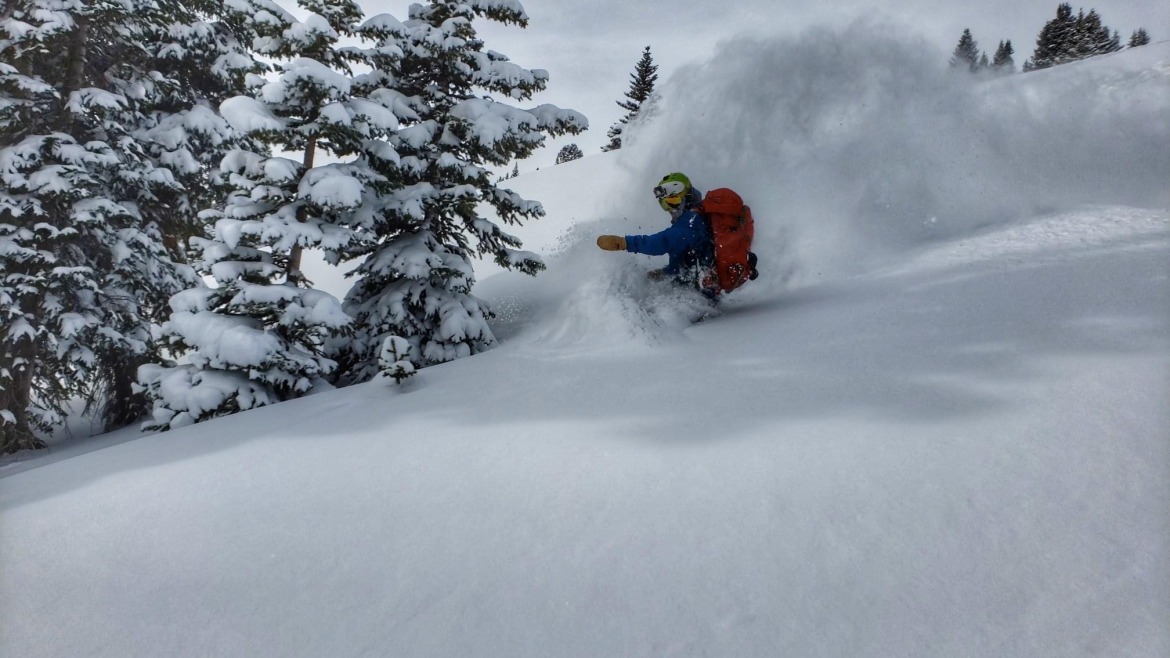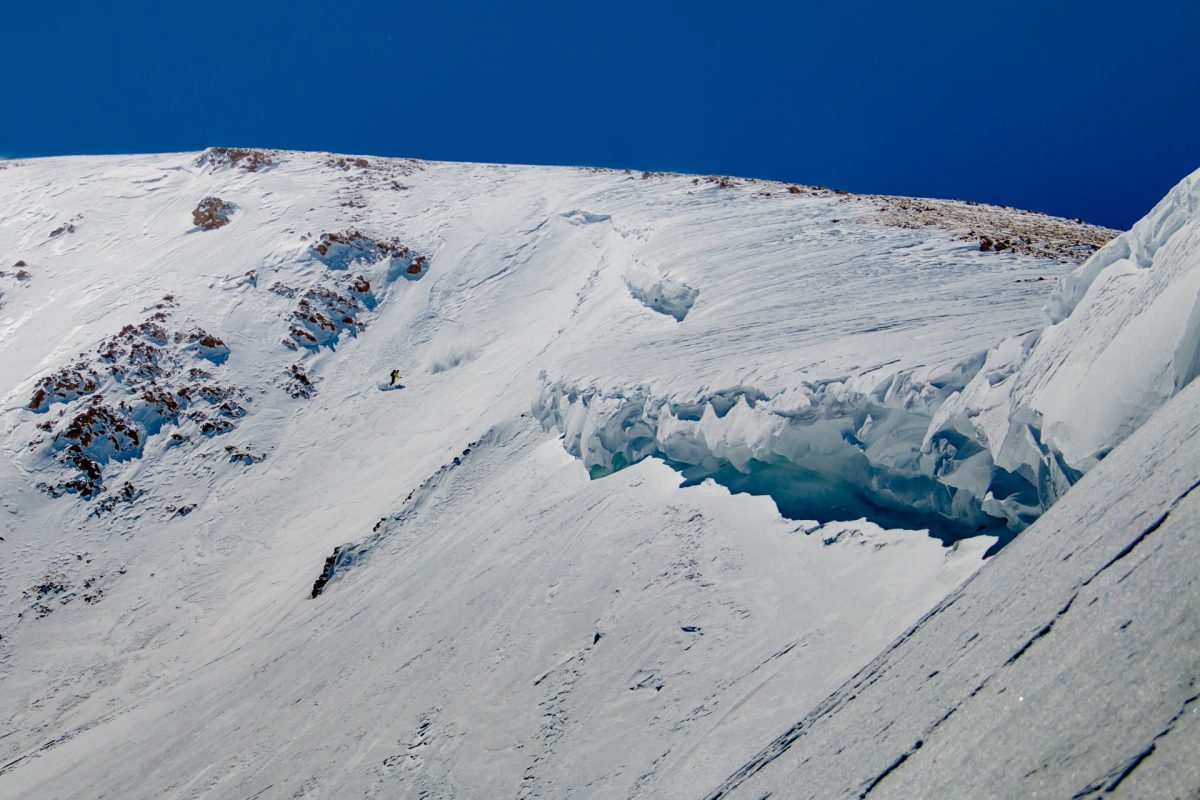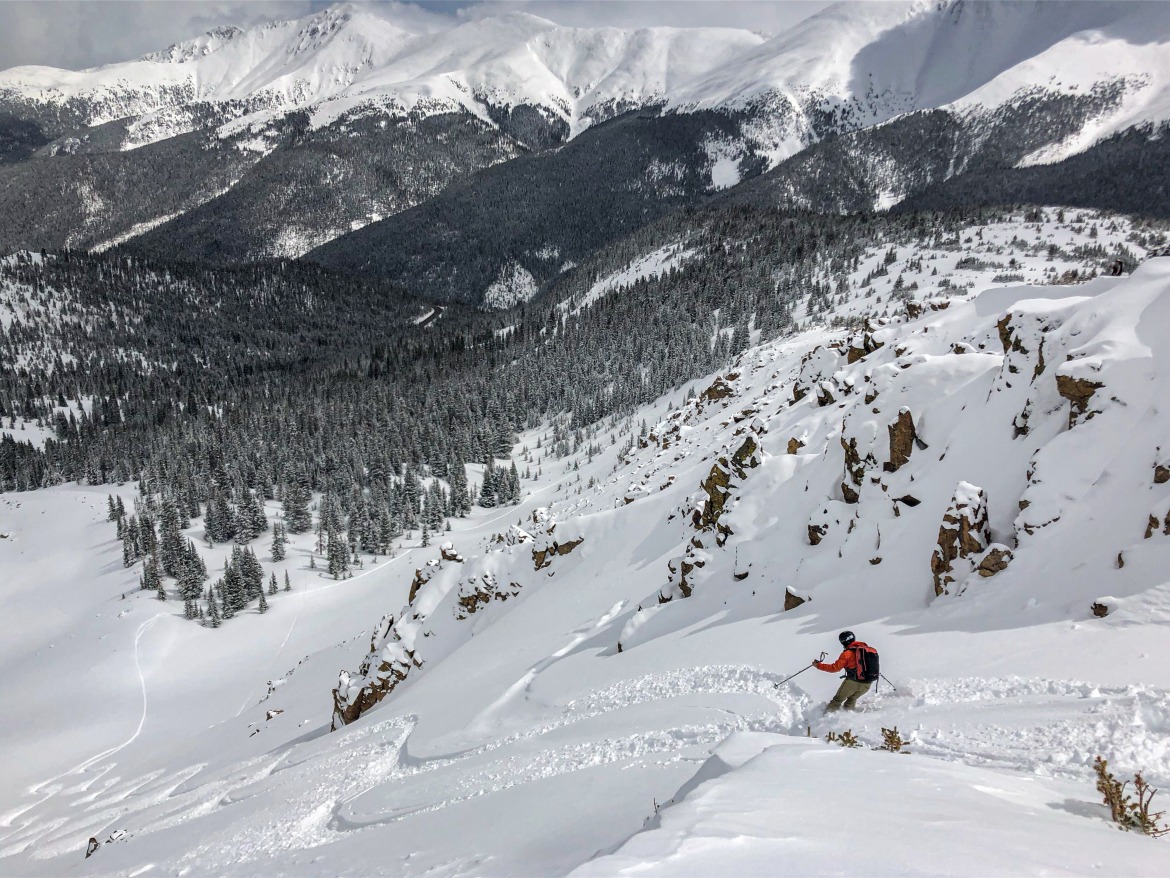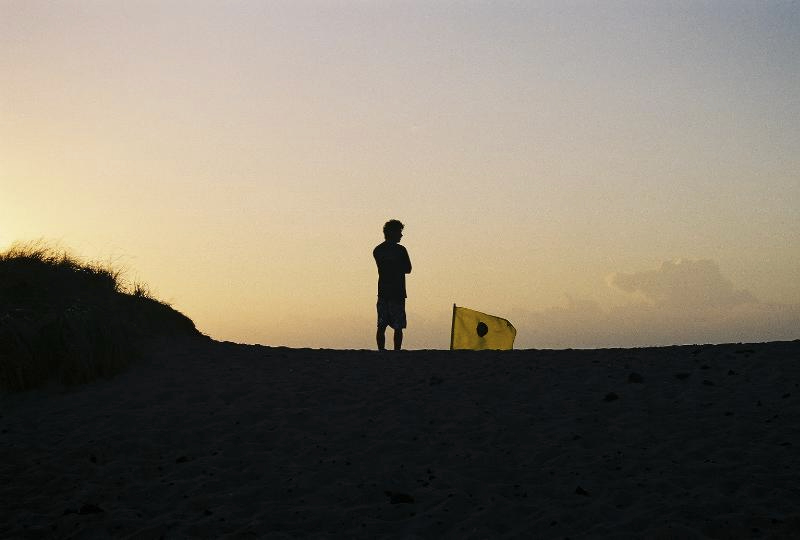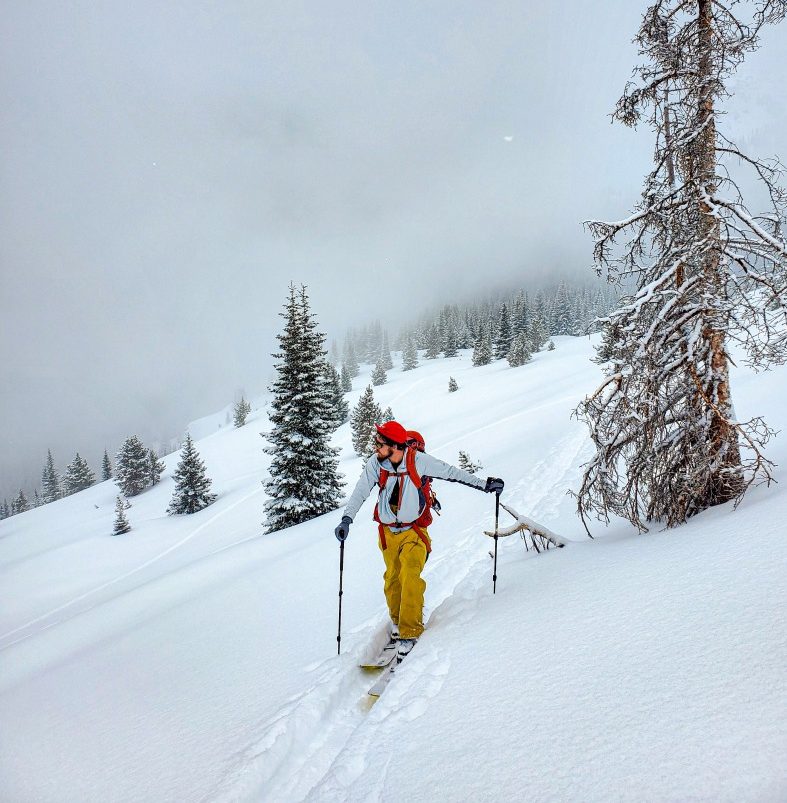Aaron Rose, a Colorado-based splitboarder, brings a grounded perspective to interpreting the dynamic backcountry realm.
To put a twist on the philosophical question – “If there’s no one around to hear an avalanche, did an avalanche really happen?” In my experience, avalanches happen whether you hear them or not.
Early on, when I first started getting into splitboarding at 30, I had no snow sense. As someone born profoundly deaf and uses a cochlear implant daily, I became dependent on others for auditory feedback in the snow, mainly because I didn’t know what to listen for.
For those unfamiliar with hearing technology, a cochlear implant bypasses the outer and middle ear and sends electrical signals directly to the brain through the inner ear. It may look like a hearing aid, but involves an internal magnet implanted on the skull near the inner ear with electrodes placed inside the cochlea. Cochlear implants are like giving blind people artificial eyesight – it may not be the same thing, but it’s usually enough to make sense of what’s happening around us.
One day during my first season, my friend and I were skinning up a west-facing aspect considered relatively mellow terrain compared to the historical avalanche paths across the valley. Then suddenly, my partner asked me if I heard the whoomph. I didn’t. Despite the forecast of the day advising caution on easterly aspects only, the sound alone was enough for him to abort the mission and turn back.
I didn’t think that this “settling” in the snow justified us calling it a day based on the slope angles, but I respected his decision and we called it a day. The experience made me think how much sound plays a role in people’s decision-making process and I wondered when I would hear a whoomph or see snow slide.
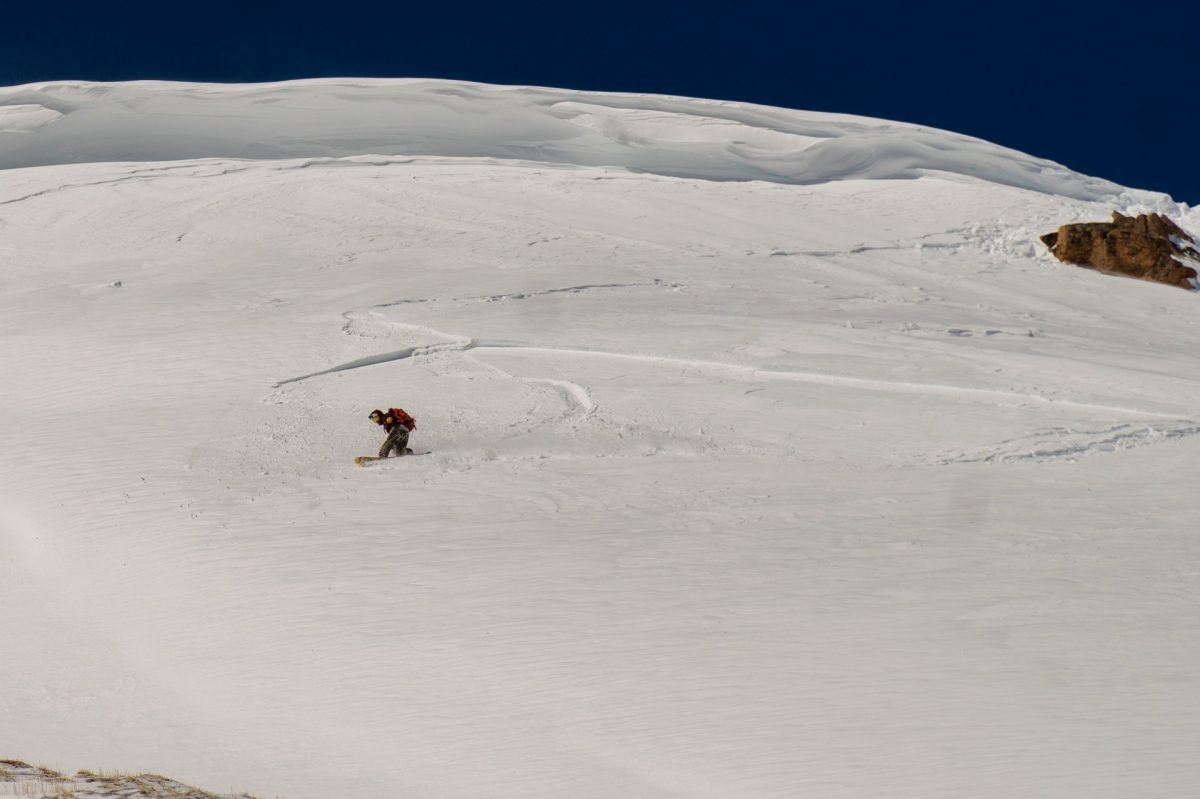
Seconds after the slab released on Mt Parnassus. Photo: Evan Green.
Slab Avalanche on Parnassus: A Green Day
It happened quickly. The first few wonky turns put me far right under the cornice, and I found myself at the mercy of a small slab avalanche. I tried to break free but realized I wasn’t going anywhere as my snowboard plowed into the snow and created a play-dough effect with the moving snow.
I had the meta-awareness to simply sit down on the slab debris and wait as it slid to a stop while keeping my hands free and preparing to swim or cover my face if needed. In reality, what seemed like an eternity was just 15 seconds from when the snow grabbed me to when I stood up and rode away.
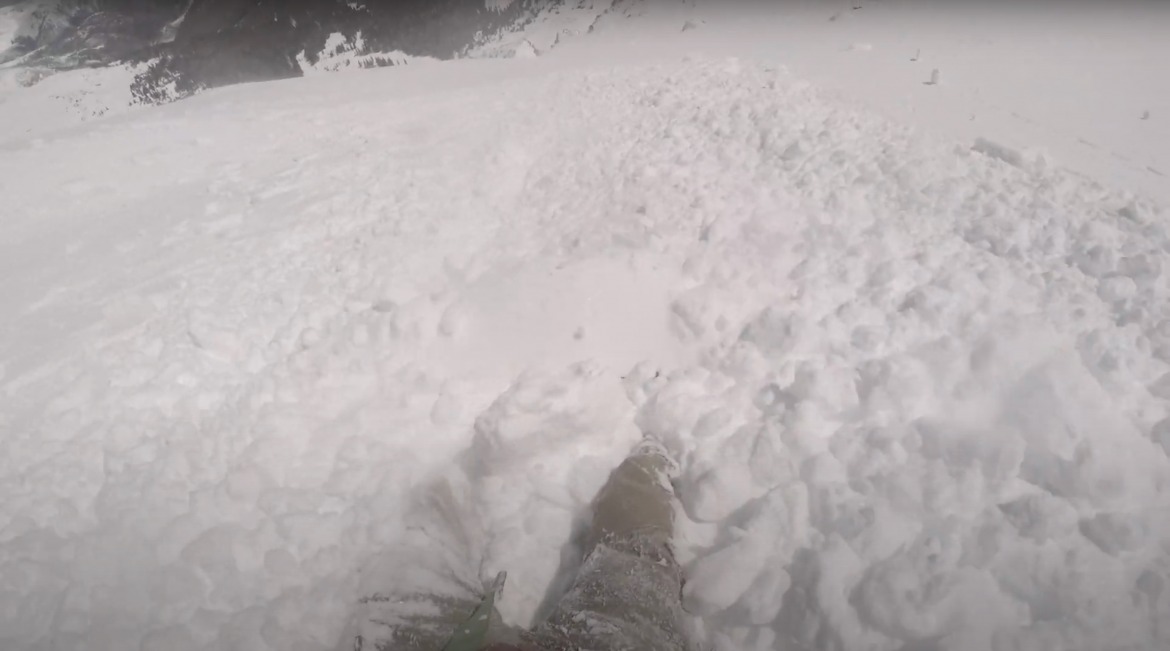
GoPro screenshot of avalanche debris on Mount Parnassus.
The “whitewash” of the slide brought me back to the multiple near-death experiences I had as a teenager, paddling my way through victory-at-sea conditions as a surfer.
Reflecting on the day, Evan and I checked the forecast and felt good about the overall approach, yet we didn’t have much discussion about the snow itself. After all, it was the middle of May, and the forecast said nothing about wind slab problems. We had admittedly been more focused on our assignment at hand with gear reviews and photography. We originally planned to skin over to the Drainpipe, the main line off Parnassus.
The idea popped into my head that maybe I could detour to skier’s left of the cornice and grab some epic shots of Evan dropping in across from the bowl instead of following him down the main line. At the point where we split up, looker’s right of the cornice, we discussed the plan that I’d go straight down skier’s left while Evan would drop down the main line off Parnassus.
We talked about the new plan and set it in motion. I had found a little protection on the skier’s left side of the cornice with the plans to drop left into smooth snow.
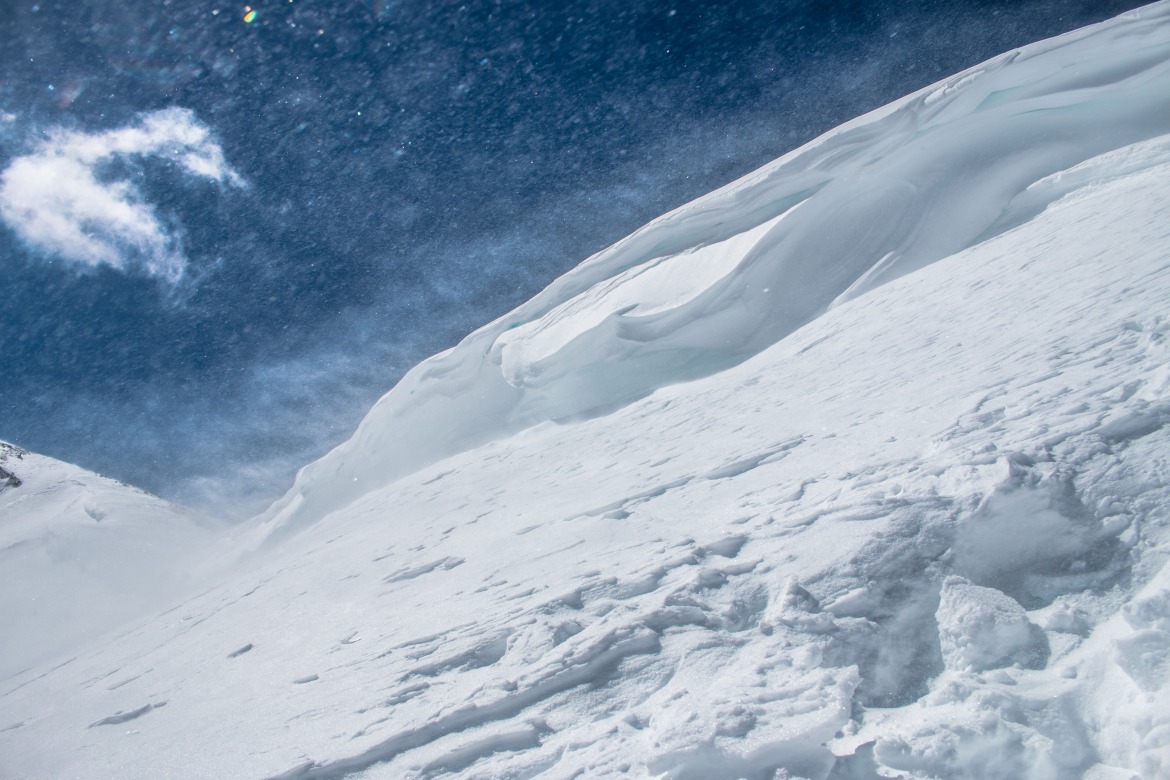
Wind blowing over the cornice with the telltale sign of deposition on the leeward side. Photo: Aaron Rose.
I didn’t pay attention to the fact that the wind was depositing fresh snow right on top of my snowboard and ended up beading up in the sun’s heat and freezing immediately. I should have realized this should have been an immediate red flag that slab formation was happening in real-time.
Reflections on Avalanche Education & The Tipping Point
The emotions I went through as I reflected on my incident ranged from anger to frustration to a realization that despite all my education, it wasn’t enough to identify avalanche terrain and read the forecast. I needed to dig into the snow more often and identify red flags. I needed to continue building on the basic knowledge I gained as I completed the recreational track.
Before the Parnassus incident, I moved through the AIARE recreational track in the first few years of splitboarding and internalized the pre and post-tour processes from planning to beacon checks. Still, I found myself avoiding avalanche terrain until everything was locked up well into April or May.
As a George Dirth Scholarship recipient, I had the mental image of Lisa Dirth sharing her son’s splitboard remnants from that tragic day on New Year’s Eve, 2013. I didn’t want to be another statistic on CAIC’s annual report.
Eventually, I started getting frustrated with my overall approach of avoiding the alpine when that was the whole point of getting into the backcountry. I started pinging people willing to help whet my appetite for steep lines.
In late March of 2019, I got the text I had been waiting for – an invitation to tour in Herman Gulch with Alex Fruehsamer, aka Frush, a former admin of the Colorado Backcountry Ski and Snowboard Facebook group, and another partner. We had initially planned to look at Pettingell Peak, but it was wind blasted, so we opted to go further in and head to the Citadel, aka Snoopy’s, which hid a classic steep northerly couloir.
The steep skin up the apron was brutal with a rockered splitboard, but I managed to follow my partners’ tracks and stay with them. Alex had done all the due diligence in digging through the snow on the way up and confirmed the recently downgraded CAIC forecast for the day. Patiently waiting for me to catch up on the skin track, Alex collected observations and made sure to share what they had seen in the snowpack on the way up. Talk about inclusion.
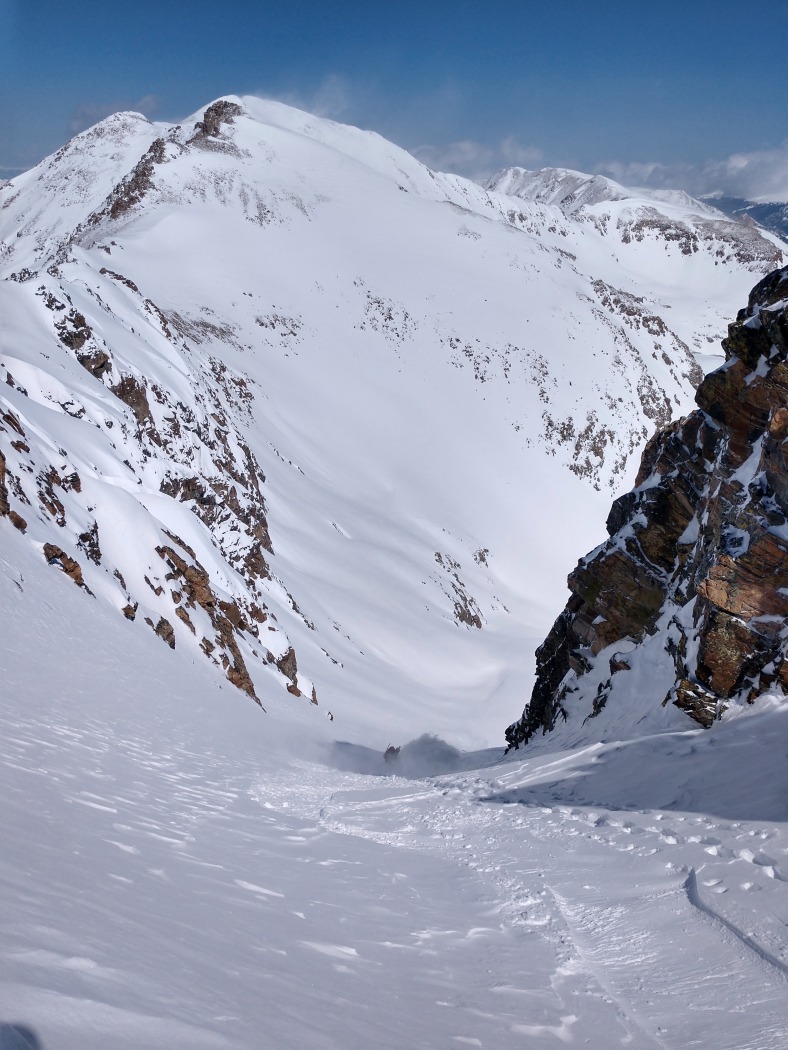
First Tracks on the Citadel. Photo: Alex Frueshamer.
Always the humble man he is, Alex offered me first tracks on my first couloir. I nervously threaded through the steep pitch’s first few feet before pushing the throttle forward and ripping into the 40+ degree face. The explosive discharges of snow blinded my vision momentarily as I went from edge to edge to control my speed. Hours to get up. Seconds to get down. This short but epic ride had become the tipping point for me. I was hooked on the alpine.
Now I would need to develop my snow sense. The Parnassus incident two months later would provide the focus shift I needed to grow in the alpine.
Finding a Crew: Growth and Trust
One aspect of skiing or snowboarding in the alpine is the realm of uncertainty in avalanche terrain and how we dance around that edge. How do you learn to read the language of the mountains? I found the first few years challenging in terms of finding people who would help elevate my knowledge in terrain management. I felt more of a liability at times with my fear of anything above 28 degrees on top of my novice fitness levels when reaching out to other individuals well-established in the Colorado backcountry scene. It didn’t help that I had difficulty when out of sight of my partners with radio communications.
I continued to tour with a mix of individuals from various backgrounds and with different risk tolerances and approaches to avalanche terrain management. Eschewing the basic approach of avoiding everything below a certain angle, I focused on the bigger picture of overhead danger, terrain traps, and test slopes for feedback. If I wanted to go after big lines as a splitboarder, I needed to know what I was getting myself into.
I’d eventually connect with Seth Linden on the skin track through Alex Frueshamer. Our mutual interest in meteorology kindled a backcountry bond that continues to this day. We had the same sense of adventure and risk tolerance. We had the shared experience of being caught in an avalanche, and we both understood the delicate balance between our desires to live on the edge and the need to come back home to our families.
Because of Seth’s visibility in forecasting Colorado weather through his Facebook group, he had access to well-established backcountry skiers in the Colorado backcountry scene for mentorships. Along with our expanded crew, we found ourselves collectively pushing each other to assess and determine risk management while acknowledging each other’s limits at the time. We all were placing trust in each other to bring everyone home alive.
Life threw curveballs in the next few years; from a broken ankle to a global pandemic, I continued to communicate with my touring partners. We monitored daily observations posted to the Facebook group and the CAIC website. I eventually learned to see through the visual noise of the winter landscape as I hunted for avy signs, layers in the snowpack, and changes in aspects. Even though Parnassus changed my focus, having solid partners helped me to enhance my snow sense in the alpine.
Snow versus Surf – A Comparison of the Senses
I grew up in southern North Carolina and eventually discovered surfing as a teenager. The east coast weather patterns provided a mix of everything from short-period wind chop to overhead barrels spun off from hurricanes.
After I experienced my first wave on a Hawaiian longboard, I eventually progressed to riding shortboards. I got stoked enough to the point of skipping class in high school to catch big swells, especially during hurricane season.
My dad supported my passions and was clueless enough to drive me to the beach when hurricanes were churning just offshore with the ocean looking like a class 5 river on steroids.
We were usually hours away from the closures that would keep people off (and on) the island. He would drop me off at the island’s north end and meet me at the south end as the current was strong enough to pull you 4 miles in less than half an hour. In these chaotic scenes, I would channel my beast mode and stick it out for almost two hours before getting spit over the jetty and into the inlet.
As a novice, it took a while to develop “surf sense” in terms of reading approaching swells and dropping into them. I usually ended up over the falls with copious amounts of seawater filling my sinus cavity each time. Each failure motivated me to try again and rewarded me with short bursts of shredding and the thrill of moving across the water. The cochlear implant stayed at home so everything was all visual when in the water.
Back then, before the internet became omnipresent, magazines and surf shops were the sources of all things surf related. Yet, there really was nothing about learning to read swells, just the standard trip/stoke report, bragging rights, and legend profiles. Experience was the only way to develop surf sense.
Over time, I learned to recognize the patterns of the ocean. What seemed like unpredictable intensity became a comprehensible chaos of water cascades. The sand bars shifted as the tides ebbed and flowed like clockwork. Rip tides became resources for energy conservation. There was no sound to listen to, just visual clues in the currents and on the horizon.
The difference between surf sense and snow sense, though, is that the danger and risk in surfing are much more apparent. Conditions change on a daily, if not hourly, basis in both lifestyles, yet you typically see the clean-up swells where you have a choice to paddle for your life or to prepare for a long hold and thrashing underwater.
Traveling in avalanche terrain, specifically in the wintertime, has a level of unknown danger embedded into the dynamics. Snapshots via snowpits may not tell the whole story, and it may come down to experience to recognize when and where is the right place and the right time to drop in with minimal consequence.
Sans Sound (and on Snow)
More experienced skiers and splitboarders may be dialed in with their gear and technique to the point they are in tune with the snowpack and actively listen through their breathing while feeling the snow break or collapse beneath them. However, it still comes down to effective data collection and field observations to identify the day’s avalanche hazards. Avalanches don’t care whether you can hear or not.
Before any tour, I typically check various sources, from the CAIC website and recent avalanche reports to social media posts highlighting problems of the day. The weather is one of the most important aspects of my data collection, and Seth’s weather forecasts help me to plan my tours in advance to hone them within the context of the avalanche hazard.
I make mental records in my head on a seasonal basis of the snowfall cycles in my usual zones. And I refer to Seth and other weather nerds for historical perspectives. The inclusion of historical data on the CAIC website helps provide context for historical paths and scenarios to avoid.
With all this data in the back of my head, I turn to my crew and have conversations about what we want to do, where we want to go, and why we want to go there. Sometimes the plan goes accordingly, and sometimes we learn from our missteps about whether the snowpack was good on a particular aspect or the avalanche problem was more pronounced than we expected.
On the way to the trailhead, I survey the winds up high on the ridges to see if there’s snow transport. As I pull up to the trailhead, depending on how much dawn light there is, I observe snow coverage on different aspects. Memory recall plays a big role in my thoughts as I complete my visual scans and make mental calculations on loading and consequences.
Even though I may be effective in using my cochlear implant, I still feel deaf when it comes to listening to the snow underneath me. Stepping off the skin track gives me the opportunity to feel the new snow versus the old. I find steep banks and wind-drifted snow to kick off in order to gauge the reactivity. I poke holes with my poles and get on my knees to dig into the snow with my hands. It’s a matter of hunting for those layer interfaces to reinforce the forecast for the day.
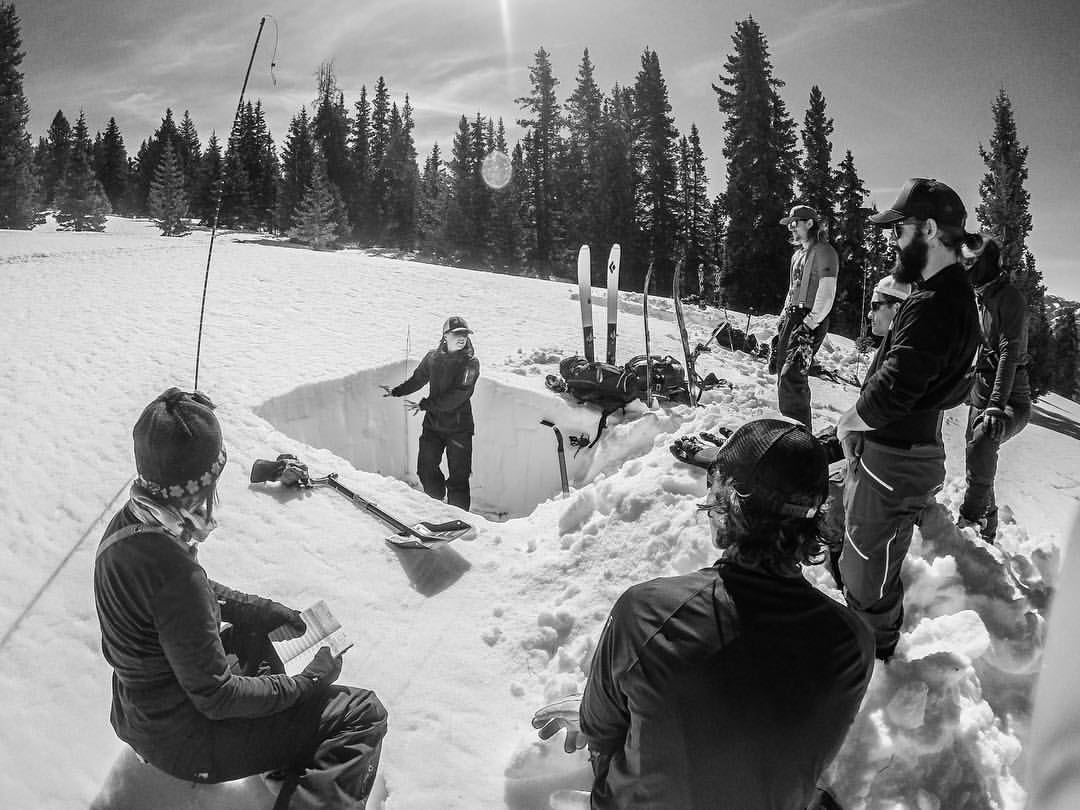
Anne St. Claire covers the basics of digging and studying a snow pit during a 2017 AIARE Level 1 Course on Chalk Mountain in Colorado. Photo: Aaron Rose.
The first time I dug a pit for my AIARE 1 class, it was a novel experience to think about how to search for those layers and what it meant to have a hard layer above or below a weak layer. Over time as I dug hasty pits to look for layers, it became more apparent what was in the snowpack without pulling out a pencil or a ruler. Sometimes I’d pull out the shovel and quickly isolate columns to see where things lie, but our missions typically didn’t call for a full snow pit to verify the forecast.
As a recreational user, the few times I would invest time into a proper snowpit is when I’m in a new area and don’t have a good record or sense of the historical weather during the season or I want to refresh my pit skills with others. Otherwise, it’s a matter of leaving it to the professionals for accurate observations.
In our shallow snowpack during the early season, it was easy to dig down deep enough with a hand and grab a handful of that sugar snow, aka facets, aka our worst enemy. Moving up through the snowpack, depending on the conditions you could isolate strong layers and remove them as a slab out of the hole.
Between the sugary snow and the hard slabs, it becomes a matter of interpreting the potential for the snow to move and evaluating the consequences of the terrain. As the season progressed, we always assumed the facets were there, and it was a matter of terrain management and hazard avoidance.
Springtime comes with a different vibe in terms of stepping it up on slope angles and determining whether the snow is consolidated enough throughout the snowpack. Throughout the day, it’s mainly a matter of determining whether the surface snow isn’t melted enough to sluff out underneath you. My friends’ close calls do serve as a reminder of the lurking dangers within a transitional snowpack.
Sticking my hand in the snow gives me a deeper sense of the historical record, but you can’t always see or feel the bottom. In the end, it comes down to checking the avalanche reports daily and getting field observations over time to observe changes in the snowpack. From there, it’s a matter of deciding whether we want to stick to the plan or bail.
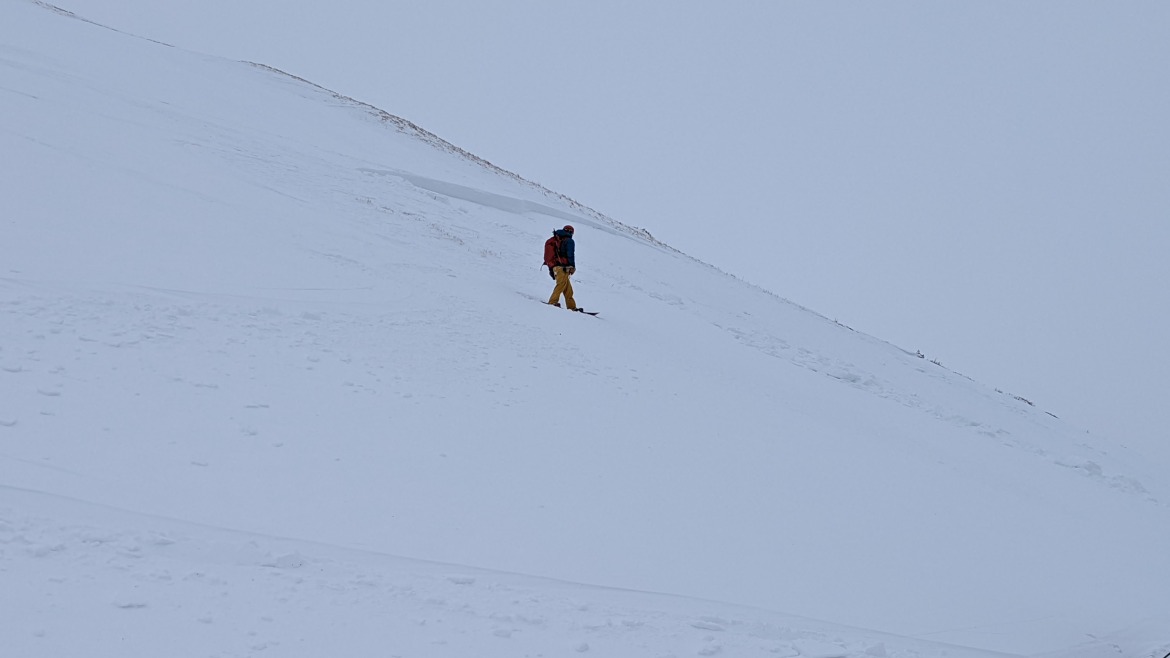
Looking at the crown of an avalanche triggered by a partner in the fall of 2021. I stopped short of the aspect change and avoided getting swept. Photo: Seth Linden.
One of the most important processes is the debriefing after a tour. In my crew, we discussed what was good and what wasn’t about the snowpack. It’s not uncommon to come across avalanche debris or get feedback from the snowpack on our tours, so these become conversation starters.
It comes down to the process itself of data collection, field observations, and interpretations. Auditory input can certainly be integrated into the overall picture. Still, it is a small piece of the puzzle: The observed and felt clues yield the most evidence to consider terrain management and avalanche avoidance. Snow sense is fundamentally built on a visual-tactile experience. Auditory stimulus is secondary, at least for me.
Aaron Rose originally came to Colorado to work as a teacher of the deaf and hard of hearing. Three years later, he switched roles and became a stay-at-home dad while doing freelance media production through his company, Cue Cognatio. Aaron joined the outdoor industry as a ski technician then as a producer for Engearment. Aaron co-founded www.cuecollege.org, an online platform for Cued Speech instruction and currently serves as marketing and outreach coordinator at Marion Downs Center, a non-profit audiology clinic in Denver. When not chasing powder in the backcountry, Aaron enjoys spending time outdoors with his wife and daughter.

